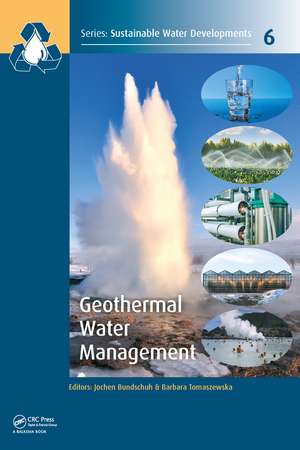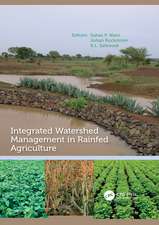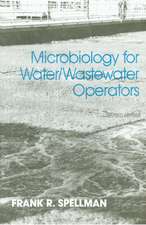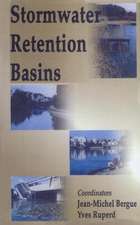Geothermal Water Management: Sustainable Water Developments - Resources, Management, Treatment, Efficiency and Reuse
Editat de Jochen Bundschuh, Barbara Tomaszewskaen Limba Engleză Paperback – 8 aug 2017
The research field includes crucial new areas of study:
• an improvement in the management of freshwater resources through the use of residual geothermal water;
• a review of the technologies available in the field of geothermal water treatment for its (re)use for energetic purposes and freshwater production, and
• the development of balneotherapy.
The book is aimed at professionals, academics and decision makers worldwide, water sector representatives and administrators, business enterprises specializing in renewable energy management and water treatment, working in the areas of geothermal energy usage, water resources, water supply and energy planning. This book has the potential to become a standard text used by educational institutions and research & development establishments involved in the geothermal water management.
Preț: 689.04 lei
Preț vechi: 994.61 lei
-31% Nou
Puncte Express: 1034
Preț estimativ în valută:
131.84€ • 138.03$ • 109.10£
131.84€ • 138.03$ • 109.10£
Carte tipărită la comandă
Livrare economică 05-19 aprilie
Preluare comenzi: 021 569.72.76
Specificații
ISBN-13: 9781138749009
ISBN-10: 1138749001
Pagini: 462
Dimensiuni: 174 x 246 x 28 mm
Greutate: 0.92 kg
Ediția:1
Editura: CRC Press
Colecția CRC Press
Seria Sustainable Water Developments - Resources, Management, Treatment, Efficiency and Reuse
ISBN-10: 1138749001
Pagini: 462
Dimensiuni: 174 x 246 x 28 mm
Greutate: 0.92 kg
Ediția:1
Editura: CRC Press
Colecția CRC Press
Seria Sustainable Water Developments - Resources, Management, Treatment, Efficiency and Reuse
Cuprins
Section I Resources, geochemical properties and environmental implications of geothermal water
1. A global assessment of geothermal resources
Marek Hajto &Anna Sowizdzał
1.1 Introduction
1.2 Definitions and classification of geothermal resources
1.3 Methods of regional assessment of geothermal resources
1.4 New concepts of geothermal resources classification
1.5 Results of geothermal resources assessment
2. Reinjection of cooled water back into a reservoir
Leszek Pajak & Barbara Tomaszewska
2.1 Introduction
2.2 Mathematical model for assessing the conditions for injecting water into a rock formation
2.3 Injection of saline water into rock formation
2.4 Summary
3. Geothermal and hydrogeological conditions, geochemical properties and uses of geothermal waters of the Slovakia
Dušan Bodiš, Anton Remšík, Radovan Cernák, Daniel Marcin, Zlatica Ženišová & Renáta Flaková
3.1 Introduction
3.2 Geological structure
3.3 Characteristics of geothermal bodies
3.4 Geothermal waters' chemical composition
3.5 Abstraction and thermal energy potential of geothermal waters
4. Resources, geochemical features and environmental implications of the geothermal waters in the continental rift zone of the Büyük Menderes,Western Anatolia, Turkey
N. Özgür
4.1 Introduction
4.2 Geologic setting
4.3 Hydrogeology and hydrogeochemistry
4.4 Resources and geothermal potential
4.5 Environmental implications
4.6 Model of the geothermal waters in the rift zone of the Büyük Menderes
Section II Treatment of geothermal water for reuse
5. Analytical procedures for ion quantification supporting water treatment processes
Ewa Kmiecik
5.1 Introduction
5.2 Groundwater sampling
5.3 Quality assurance/quality control (QA/QC) program
5.4 QA/QC program in geothermal water monitoring – the case of Banska PGP-1 well (Banska Nizna, Poland)
5.5 Summary
6. Treatment of geothermal waters for industrial and agricultural purposes
Nalan Kabay, Pınar Yanar Sözal, Emre Yavuz, Mithat Yüksel & Ümran Yüksel
6.1 Introduction
6.2 Geothermal potential of Turkey
6.3 Main utilization areas of geothermal energy
6.4 Environmental issues
6.5 Chemistry of geothermal fluids
6.6 Treatment of geothermal water
7. Removal of boron and arsenic from geothermal water by ion-exchange
Nalan Kabay, Idil Y. Ipek, Pelin K. Yilmaz, Saba Samatya, Marek Bryjak, Kazuharu Yoshizuka, S. Ali Tuncel, Ümran Yüksel & Mithat Yüksel
7.1 Introduction
7.2 Removal of boron from geothermal water by ion-exchange
7.3 Removal of arsenic from geothermal water by ion-exchange
8. Membrane techniques in the treatment of geothermal water for fresh and potable water production
Michał Bodzek & Krystyna Konieczny
8.1 Introduction
8.2 Desalination methods
8.3 Concentrate utilization
8.4 Integrated desalination systems
8.5 The consideration of energy issues in water desalination
8.6 Economic analyses of desalination processes
8.7 Final remarks
9. Review of direct discharge and recovery of reverse osmosis concentrates
Raquel Ibáñez, Antia Pérez-González, Javier Pinedo, Pedro Gomez, Ana Maria Urtiaga & Inmaculada Ortiz
9.1 Introduction
9.2 Global desalination overview
9.3 RO desalination: characteristics and drawbacks
9.4 RO concentrates: influence of production site
9.5 Adverse effects of current ro concentrate management options
9.6 Treatment technologies of ro concentrates: review
10. Geothermal water treatment in Poland
Barbara Tomaszewska
10.1 Introduction
10.2 Characteristics of geothermal waters
10.3 Research methodology
10.4 Results and discussion
10.5 Conclusions
Section III The uses of geothermal water in agriculture
11. Coupling geothermal direct heat with agriculture
Jochen Bundschuh, Barbara Tomaszewska, Noreddine Ghaffour, Ihsan Hamawand, Hacene Mahmoudi & Mattheus Goosen
11.1 Introduction
11.2 Sustainability by integrating geothermal options into agriculture
11.3 Geothermal direct heat applications
11.4 Agriculture within the cascade system of geothermal direct heat utilization
11.5 Geothermal energy for thermal water desalination
11.6 Geothermal greenhouses development heating/cooling, ventilation, humidification, desalination
11.7 Geothermal aquifers as freshwater source
11.8 Conclusions
Section IV The uses of geothermal water in balneotherapy
12. Short history of thermal healing bathing
Barbara Kiełczawa
12.1 Introduction
12.2 The Americas
12.3 Asia and the Middle East
12.4 European countries
13. Balneological use of geothermal springs in selected regions of the world
Barbara Kiełczawa
13.1 Introduction
13.2 Africa
13.3 The Americas
13.4 Asia and Middle East
13.5 European countries
13.6 SPA, wellness and health resort organizations
13.7 Summary
14. The importance of an integrated analytic approach to the study of physico chemical characteristics of natural thermal waters used for pelotherapy aims: Perspectives for reusing cooled thermal waters for treatments related to thermalism applications
Davide Rossi, Dariusz Dobrzynski, Isabella Moro, Mirella Zancato & Nicola Realdon
14.1 Introduction
14.2 Application of the integrated analytical approach and tensiometry on thermalism
14.3 Perspectives for using cooled thermal waters for thermal water treatments: Jelenia Góra hsw and borowina muds
1. A global assessment of geothermal resources
Marek Hajto &Anna Sowizdzał
1.1 Introduction
1.2 Definitions and classification of geothermal resources
1.3 Methods of regional assessment of geothermal resources
1.4 New concepts of geothermal resources classification
1.5 Results of geothermal resources assessment
2. Reinjection of cooled water back into a reservoir
Leszek Pajak & Barbara Tomaszewska
2.1 Introduction
2.2 Mathematical model for assessing the conditions for injecting water into a rock formation
2.3 Injection of saline water into rock formation
2.4 Summary
3. Geothermal and hydrogeological conditions, geochemical properties and uses of geothermal waters of the Slovakia
Dušan Bodiš, Anton Remšík, Radovan Cernák, Daniel Marcin, Zlatica Ženišová & Renáta Flaková
3.1 Introduction
3.2 Geological structure
3.3 Characteristics of geothermal bodies
3.4 Geothermal waters' chemical composition
3.5 Abstraction and thermal energy potential of geothermal waters
4. Resources, geochemical features and environmental implications of the geothermal waters in the continental rift zone of the Büyük Menderes,Western Anatolia, Turkey
N. Özgür
4.1 Introduction
4.2 Geologic setting
4.3 Hydrogeology and hydrogeochemistry
4.4 Resources and geothermal potential
4.5 Environmental implications
4.6 Model of the geothermal waters in the rift zone of the Büyük Menderes
Section II Treatment of geothermal water for reuse
5. Analytical procedures for ion quantification supporting water treatment processes
Ewa Kmiecik
5.1 Introduction
5.2 Groundwater sampling
5.3 Quality assurance/quality control (QA/QC) program
5.4 QA/QC program in geothermal water monitoring – the case of Banska PGP-1 well (Banska Nizna, Poland)
5.5 Summary
6. Treatment of geothermal waters for industrial and agricultural purposes
Nalan Kabay, Pınar Yanar Sözal, Emre Yavuz, Mithat Yüksel & Ümran Yüksel
6.1 Introduction
6.2 Geothermal potential of Turkey
6.3 Main utilization areas of geothermal energy
6.4 Environmental issues
6.5 Chemistry of geothermal fluids
6.6 Treatment of geothermal water
7. Removal of boron and arsenic from geothermal water by ion-exchange
Nalan Kabay, Idil Y. Ipek, Pelin K. Yilmaz, Saba Samatya, Marek Bryjak, Kazuharu Yoshizuka, S. Ali Tuncel, Ümran Yüksel & Mithat Yüksel
7.1 Introduction
7.2 Removal of boron from geothermal water by ion-exchange
7.3 Removal of arsenic from geothermal water by ion-exchange
8. Membrane techniques in the treatment of geothermal water for fresh and potable water production
Michał Bodzek & Krystyna Konieczny
8.1 Introduction
8.2 Desalination methods
8.3 Concentrate utilization
8.4 Integrated desalination systems
8.5 The consideration of energy issues in water desalination
8.6 Economic analyses of desalination processes
8.7 Final remarks
9. Review of direct discharge and recovery of reverse osmosis concentrates
Raquel Ibáñez, Antia Pérez-González, Javier Pinedo, Pedro Gomez, Ana Maria Urtiaga & Inmaculada Ortiz
9.1 Introduction
9.2 Global desalination overview
9.3 RO desalination: characteristics and drawbacks
9.4 RO concentrates: influence of production site
9.5 Adverse effects of current ro concentrate management options
9.6 Treatment technologies of ro concentrates: review
10. Geothermal water treatment in Poland
Barbara Tomaszewska
10.1 Introduction
10.2 Characteristics of geothermal waters
10.3 Research methodology
10.4 Results and discussion
10.5 Conclusions
Section III The uses of geothermal water in agriculture
11. Coupling geothermal direct heat with agriculture
Jochen Bundschuh, Barbara Tomaszewska, Noreddine Ghaffour, Ihsan Hamawand, Hacene Mahmoudi & Mattheus Goosen
11.1 Introduction
11.2 Sustainability by integrating geothermal options into agriculture
11.3 Geothermal direct heat applications
11.4 Agriculture within the cascade system of geothermal direct heat utilization
11.5 Geothermal energy for thermal water desalination
11.6 Geothermal greenhouses development heating/cooling, ventilation, humidification, desalination
11.7 Geothermal aquifers as freshwater source
11.8 Conclusions
Section IV The uses of geothermal water in balneotherapy
12. Short history of thermal healing bathing
Barbara Kiełczawa
12.1 Introduction
12.2 The Americas
12.3 Asia and the Middle East
12.4 European countries
13. Balneological use of geothermal springs in selected regions of the world
Barbara Kiełczawa
13.1 Introduction
13.2 Africa
13.3 The Americas
13.4 Asia and Middle East
13.5 European countries
13.6 SPA, wellness and health resort organizations
13.7 Summary
14. The importance of an integrated analytic approach to the study of physico chemical characteristics of natural thermal waters used for pelotherapy aims: Perspectives for reusing cooled thermal waters for treatments related to thermalism applications
Davide Rossi, Dariusz Dobrzynski, Isabella Moro, Mirella Zancato & Nicola Realdon
14.1 Introduction
14.2 Application of the integrated analytical approach and tensiometry on thermalism
14.3 Perspectives for using cooled thermal waters for thermal water treatments: Jelenia Góra hsw and borowina muds
Descriere
This book discusses the effective use of geothermal water and renewable energy for future needs of a modern sustainable, effective management of water resources.It determines the potential of a desalination processes to reduce total dissolved solids (TDS), enhance removal of microelements (such as arsenic and boron) and also natural radionuclides so making geothermal waters suitable for discharge into surface waters or reuse for drinking, irrigation and other purposes. The key issue of the research is utilising the retentate, which contains a concentrate of the chemical elements and compounds removed from the geothermal water.














